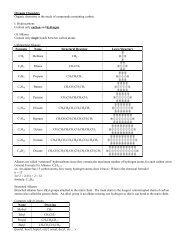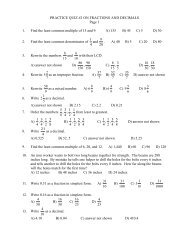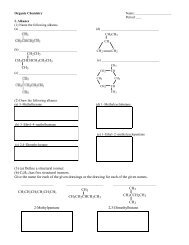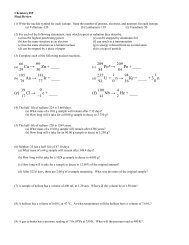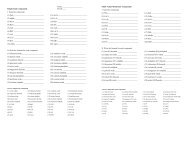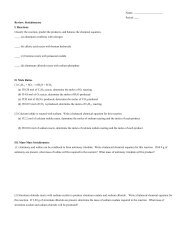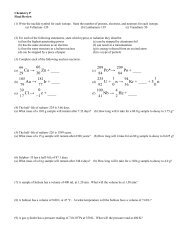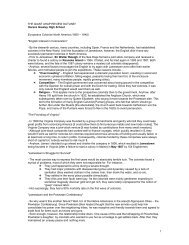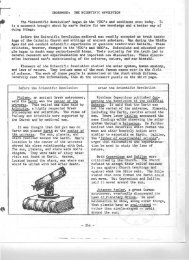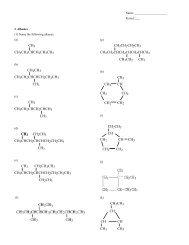Notes: Gases - yourhomework.com Home Page
Notes: Gases - yourhomework.com Home Page
Notes: Gases - yourhomework.com Home Page
Create successful ePaper yourself
Turn your PDF publications into a flip-book with our unique Google optimized e-Paper software.
<strong>Gases</strong>The Earth’s atmosphere is <strong>com</strong>posed of a mixture of the following gases:GasNitrogenOxygenArgonOther gases i. .e. water vapour, carbon dioxide, neon,helium, methane, krypton, hydrogen,etc.Content78.0%20.9%0.9%0.2%Kinetic Molecular Theory- Atoms/molecules are constantly moving.- When the temperature increases, the atoms/molecules move faster.- When the atoms/molecules move faster, theyspread out tooccupy a larger volume.- Atoms/molecules of gas exerta pressure on a surface whenthey collide with it.ex.A balloon is filled with helium. The atoms of heliumcollide with the inner surface of the balloon to create the pressuregiving the balloon its shape.PressurePressure: The amount of force exerted on a given area.Pressure is calculated accordingto the following equation:P FAF PAA FPP=pressure (Pascals, Pa)F=force (Netwons, N)A = area (meters squared, m 2 )ex.Calculate thepressure experienced when 150 N of forceis applied over 8.0 m 2 .ex.Calculate the force if 100 Paof pressure isapplied to an area of 125 m 2 .ex.Calculate the area if 500 N of force creates a pressure of25 Pa.
Measuring PressureBarometer: the instrument used to measure air pressureA barometer is filled with mercury. A tube is inverted in themercury. The pressure of the Earth’s atmosphere pushes themercury up the tube. The greater the air pressure, the higherthe mercury in the tube will be.At sea level, at 0 °C the pressure of the Earth’s atmosphere(1.00 atm) creates a column of Mercury 760 mm in height.This pressure is equivalent to 101325 Pa.1.00 atm = 760 mm Hg = 101325 Pa1 mm Hg is also called 1 torr.ex. Convert the given pressure to the indicated units.0.850 atm = _____ mm Hg = __________ PaGas Laws(1) Dalton’s LawThe total pressure of a mixture of gases is equal to the sum of the partial pressures of all the gases in the mixture.When gases are in a mixture, the pressure of each gas is referred to as the “partial” pressure as each gas in the mixturecontributes to part of the total pressure.P TotalP1 P2 P3The number of terms in the equation depends on the number of gases in the mixtureex. A mixture contains nitrogen with a partial pressure of 2.5 atm and oxygen with a partial pressure of 1.5 atm, what is the totalpressure of the mixture?ex. A mixture of air and ozone has a total pressure of 1.00x10 5 Pa. If the partial pressure of air is 9.55x10 4 Pa, what is the partialpressure of ozone?
(2) Boyle’s LawAt a constant temperature, Boyle’s Law gives the relationship between changing pressure/volume.P 1V1P2V2P 1 = initial pressureV 1 = initial volumeP 2 = final pressureV 2 = final volumeex. A sample of argon gas at 0.950 atm of pressure occupies a volume of 1.50 L. What is the volume if the pressure is increasedto 1.25 atm?ex. A sample of air under 1.50x10 5 Pa of pressure has a volume of 175 mL. What is the pressure if the volume is increased to200 mL?When pressure is increased, volume is ________________.When volume is increased, pressure is ________________.(3) Charles’ LawAt a constant pressure, Charles’ Law gives the relationship between changing volume/temperature.V1T1VT22V 1 = initial volume V 2 = final volumeT 1 = initial temperature T 2 = final temperatureTEMPERATURE MUST BE IN KELVINex. A sample of oxygen gas occupies 0.750 L at 300 K. What volume will the gas occupy if the temperature is increased to400 K?ex. A sample of chlorine gas occupies 80.0 mL at 30 °C. At what temperature will the volume be 50.0 mL?
When temperature is increased, volume is ________________.When volume is decreased, temperature is ________________.(4) Gay-Lussac’s LawAt constant volume, Gay-Lussac’s Law gives the relationship between changing pressure/temperature.P1T1PT22P 1 = initial pressureT 1 = initial temperatureP 2 = final pressureT 2 = final temperatureTEMPERATURE MUST BE IN KELVINex. A sample of nitrogen gas at 1.2 atm of pressure and 275 K is heated to 350 K. What is the resulting pressure?ex. A sample of xenon is under of pressure of 1.30x10 5 Pa at 50 °C. What is the temperature when the pressure is decreased to8.90x10 4 Pa?When temperature is increased, pressure is ________________.When pressure is decreased, temperature is ________________.(5) Combined Gas LawGives the relationship between changing pressure/volume/temperature for a gas.PV1T11P V2T22P 1 = initial pressure P 2 = final pressureV 1 = initial volume V 2 = final volumeT 1 = initial temperature T 2 = final temperatureTEMPERATURE MUST BE IN KELVINex. A balloon filled with helium has a volume of 4.0 L at 20 °C and 1.04 atm. What is the volume at 25 °C and 0.90 atm?
(6) Avogadro’s LawAt STP = Standard Temperature (0 °C or 273 K) and Pressure (1.00 atm or 101325 Pa), 1 mole of ANY gas will occupy 22.4 L.1 mole = 22.4 Lex. What is the volume of 0.300 mol of gas at STP?ex. What is the mass of 200 L of Neon at STP?ex. How many molecules of nitrogen trifluoride are contained in 125 mL at STP?(7) Ideal Gas LawGives the relationship between pressure/volume/temperature/moles of gas for any condition.PV nRTP = pressure (Pa or atm)V = volume (L)n = number of moles (mol)R = The gas constant which has a value of 0.0821 L atm/mol K OR 8314 L Pa/mol K(the given units of pressure must be used to determine which value of R to use)T = temperature (K)ex. What is the volume of a sample containing 0.550 mol of nitrogen gas at 340 K and 1.05x10 5 Pa?ex. What is the mass of a 50.0 L sample of helium at 280 K and 0.860 atm?Ideal Gas Law and Molar MassA sample of gas has a mass of 5.00 g and occupies a volume of 800 mL at 1.17 atm and 27 ºC. Determine the molar mass of thegas. Identify the monatomic gas.Ideal Gas Law and DensityA gas has a density of 0.400 g/L at 46.1 kPa and 280 K. Determine the molar mass of the gas.
Gas Stoichiometryex. Nitrogen and hydrogen <strong>com</strong>bine to form ammonia (NH 3 ).What volume and mass of nitrogen and hydrogen (at STP) would produce 8.52 g of ammonia?ex. Sulphur dioxide reacts with oxygen to produce sulphur trioxide according to the following balanced chemical equation:2SO 2 + O 2 → 2SO 3(a) If 8.50 L of sulphur dioxide and 4.00 L of oxygen and are present at 1.15 atm and 25 °C, which reactant is limiting andwhich is excess?(b) What would be the mass and volume of sulphur trioxide produced?(c) If the reaction actually produces 26.0 g of sulphur trioxide, what is the percent yield?



